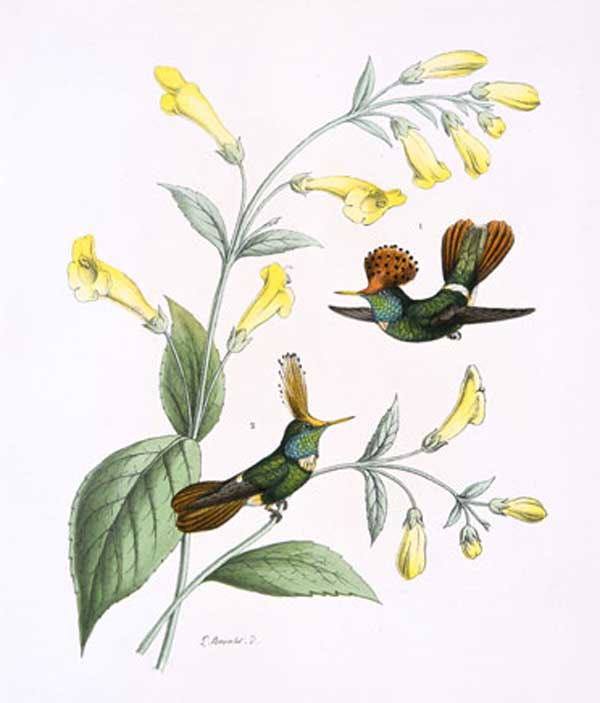
Lophornis stictolophus (*)
Superregnum: Eukaryota
Regnum: Animalia
Subregnum: Eumetazoa
Cladus: Bilateria
Cladus: Nephrozoa
Superphylum: Deuterostomia
Phylum: Chordata
Subphylum: Vertebrata
Infraphylum: Gnathostomata
Superclassis: Tetrapoda
Cladus: Reptiliomorpha
Cladus: Amniota
Classis: Reptilia
Cladus: Eureptilia
Cladus: Romeriida
Subclassis: Diapsida
Cladus: Sauria
Infraclassis: Archosauromorpha
Cladus: Crurotarsi
Divisio: Archosauria
Subsectio: Ornithodira
Subtaxon: Dinosauromorpha
Cladus: Dinosauria
Ordo: Saurischia
Cladus: Eusaurischia
Cladus: Theropoda
Cladus: Neotheropoda
Cladus: Averostra
Cladus: Tetanurae
Cladus: Avetheropoda
Cladus: Coelurosauria
Cladus: Maniraptoromorpha
Cladus: Maniraptoriformes
Cladus: Maniraptora
Cladus: Pennaraptora
Cladus: Eumaniraptora
Cladus: Avialae
Infraclassis: Aves
Cladus: Euavialae
Cladus: Avebrevicauda
Cladus: Pygostylia
Cladus: Ornithothoraces
Cladus: Euornithes
Cladus: Ornithuromorpha
Cladus: Ornithurae
Cladus: Carinatae
Parvclassis: Neornithes
Cohors: Neognathae
Ordo: Apodiformes
Familia: Trochilidae
Subfamilia: Trochilinae
Genus: Lophornis
Species: Lophornis stictolophus
Name
Lophornis stictolophus Salvin & Elliot, 1873
References
Ibis p.280
Vernacular names
English: Spangled Coquette
español: Coqueta coronada
فارسی: لوند پولکدار
suomi: Tuliharjakolibri
français: Coquette pailletée
magyar: Fénylő kacérkolibri
Nederlands: Roodkuifkoketkolibrie
svenska: Glanskokott
The spangled coquette, coquette pailletée (French), coqueta coronada, or coqueta lentejuelada (both Spanish) (Lophornis stictolophus) is a species of hummingbird in the "brilliants", tribe Lesbiini of subfamily Lesbiinae. It is found in Brazil, Colombia, Ecuador, Peru, and Venezuela.[3][4][5]
Taxonomy and systematics
The spangled coquette is believed to be most closely related to the short-crested coquette (L. brachylophus) and rufous-crested coquette (L. delattrei).[6] It is monotypic.[3]
Copalinga Lodge, Ecuador / flash photo
Description
The spangled coquette is 6.4 to 6.9 cm (2.5 to 2.7 in) long. Both sexes have a short, straight, red bill with a black tip and bronzy green upperparts with a white band across the rump. Their lower rump and uppertail coverts are purplish bronze. Adult males have a short, bushy, rufous crest with black tips on the feathers, and short rufous and iridescent green cheek tufts. Its throat is iridescent green with a few white-tipped feathers and the rest of the underparts bronzy green. Its central tail feathers are green and the rest cinnamon-rufous with black tips. The adult female does not have the male's crest or cheek tufts. It has a whitish throat with large rufous spots. It underparts are cinnamon, often with green spots. The central tail feathers are green and the rest are cinnamon with black bars near the end and buff tips. Juveniles are similar to the adult female but have a grayish throat.[6]
Distribution and habitat
According to the International Ornithological Committee (IOC) and Clements taxonomy, the spangled coquette is found from western Venezuela south through eastern Colombia and Ecuador into northern Peru.[3][7] The South American Classification Committee of the American Ornithological Society (SACC) places it in Brazil as well.[5] It inhabits the edges and clearings of humid forest, cerrado, and drier scrubby landscapes. In elevation it is found as high as 1,300 m (4,300 ft).[6]
Behavior
Movement
The spangled coquette is sedentary.[6]
Feeding
The spangled coquette feeds on the nectar of a variety of flowering plants, typically at tree-top level, though details of its diet are lacking. It "steals" nectar from the territories of larger hummingbirds. It catches arthropods by hawking from a perch.[6]
Breeding
Nothing is known about the spangled coquette's breeding phenology.[6]
Dickcissel male perched on a metal pole singing, with neck stretched and beak open.
Songs and calls
Listen to spangled coquette on xeno-canto
Vocal and non-vocal sounds
The spangled coquette is mostly silent. It gives "a hight, sharp 'tsip'" while feeding. Its wings make "a low bee-like humming" when hovering.[6]
Status
The IUCN originally assessed the spangled coquette as Near Threatened but since 2004 has rated it as being of Least Concern. Its population size and trend are not known.[1] It is "[g]enerally rare, but no immediate threats recorded so far" and appears to accept some human-made habitats.[6]
Copalinga Lodge, Ecuador / flash photo
Copalinga Lodge, Ecuador / flash photo
References
BirdLife International (2016). "Spangled Coquette Lophornis stictolophus". IUCN Red List of Threatened Species. 2016: e.T22687211A93145065. doi:10.2305/IUCN.UK.2016-3.RLTS.T22687211A93145065.en. Retrieved 25 January 2022.
"Appendices | CITES". cites.org. Retrieved 2022-01-14.
Gill, F.; Donsker, D.; Rasmussen, P. (July 2021). "IOC World Bird List (v 12.1)". doi:10.14344/IOC.ML.11.2. Retrieved January 15, 2022.
HBW and BirdLife International (2020) Handbook of the Birds of the World and BirdLife International digital checklist of the birds of the world Version 5. Available at: http://datazone.birdlife.org/userfiles/file/Species/Taxonomy/HBW-BirdLife_Checklist_v5_Dec20.zip [.xls zipped 1 MB] retrieved May 27, 2021
Remsen, J. V., Jr., J. I. Areta, E. Bonaccorso, S. Claramunt, A. Jaramillo, D. F. Lane, J. F. Pacheco, M. B. Robbins, F. G. Stiles, and K. J. Zimmer. Version 24 August 2021. Species Lists of Birds for South American Countries and Territories. https://www.museum.lsu.edu/~Remsen/SACCCountryLists.htm retrieved August 24, 2021
Züchner, T. and P. F. D. Boesman (2020). Spangled Coquette (Lophornis stictolophus), version 1.0. In Birds of the World (J. del Hoyo, A. Elliott, J. Sargatal, D. A. Christie, and E. de Juana, Editors). Cornell Lab of Ornithology, Ithaca, NY, USA. https://doi.org/10.2173/bow.spacoq1.01 retrieved January 25, 2022
Clements, J. F., T. S. Schulenberg, M. J. Iliff, S. M. Billerman, T. A. Fredericks, J. A. Gerbracht, D. Lepage, B. L. Sullivan, and C. L. Wood. 2021. The eBird/Clements checklist of Birds of the World: v2021. Downloaded from https://www.birds.cornell.edu/clementschecklist/download/ Retrieved August 25, 2021
Retrieved from "http://en.wikipedia.org/"
All text is available under the terms of the GNU Free Documentation License


